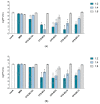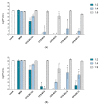Vaginal Lactobacilli Supernatants Protect from Herpes Simplex Virus Type 1 Infection in Cell Culture Models
- PMID: 38473739
- PMCID: PMC10931810
- DOI: 10.3390/ijms25052492
Vaginal Lactobacilli Supernatants Protect from Herpes Simplex Virus Type 1 Infection in Cell Culture Models
Abstract
A healthy vaginal microbiota hosts Lactobacillus as the most predominant genus. Lactobacilli play a role in human health through the production of diverse antimicrobial substances that can act against human pathogens or modulate the immune system. Previous reports highlighted the ability of vaginal lactobacilli to counteract viruses causing STIs, e.g., HIV-1 and HSV-2. In this report, we analyze the activity of supernatants of vaginal lactobacilli against HSV-1 infection, which is becoming increasingly relevant as a STI. We show that the supernatants of two vaginal Lactobacillus species (i.e., L. crispatus and L. gasseri) were active at neutralizing HSV-1 infection in two different cell lines of human and simian origin. Specifically, we demonstrate that L. crispatus strains are the most effective in antiviral activity, as evidenced by the comparison with a vaginal pathogen taken as reference. The effect was specific and not attributable to the generic toxicity of the supernatants to the cells. Our results pave the way for the development of probiotics to limit the impact of HSV-1 infection on women's health.
Keywords: HeLa cells; Vero cells; cultural supernatants; herpes simplex virus type 1; vaginal lactobacilli; virus growth inhibition.
Conflict of interest statement
The authors declare no conflicts of interest.
Figures





Similar articles
-
Protective Mechanisms of Vaginal Lactobacilli against Sexually Transmitted Viral Infections.Int J Mol Sci. 2024 Aug 23;25(17):9168. doi: 10.3390/ijms25179168. Int J Mol Sci. 2024. PMID: 39273118 Free PMC article. Review.
-
Vaginal Lactobacillus gasseri CMUL57 can inhibit herpes simplex type 2 but not Coxsackievirus B4E2.Arch Microbiol. 2015 Jun;197(5):657-64. doi: 10.1007/s00203-015-1101-8. Epub 2015 Mar 10. Arch Microbiol. 2015. PMID: 25752765 Free PMC article.
-
Antiviral effects of Lactobacillus crispatus against HSV-2 in mammalian cell lines.J Chin Med Assoc. 2018 Mar;81(3):262-267. doi: 10.1016/j.jcma.2017.07.010. Epub 2017 Oct 13. J Chin Med Assoc. 2018. PMID: 29037754
-
Inhibition of herpes simplex virus type 2 by vaginal lactobacilli.J Physiol Pharmacol. 2009 Dec;60 Suppl 6:19-26. J Physiol Pharmacol. 2009. PMID: 20224147
-
Vaginal microbiota and the potential of Lactobacillus derivatives in maintaining vaginal health.Microb Cell Fact. 2020 Nov 7;19(1):203. doi: 10.1186/s12934-020-01464-4. Microb Cell Fact. 2020. PMID: 33160356 Free PMC article. Review.
Cited by
-
Lactobacilli-Derived Postmetabolites Are Broad-Spectrum Inhibitors of Herpes Viruses In Vitro.Int J Mol Sci. 2024 Dec 25;26(1):74. doi: 10.3390/ijms26010074. Int J Mol Sci. 2024. PMID: 39795933 Free PMC article.
-
Protective Mechanisms of Vaginal Lactobacilli against Sexually Transmitted Viral Infections.Int J Mol Sci. 2024 Aug 23;25(17):9168. doi: 10.3390/ijms25179168. Int J Mol Sci. 2024. PMID: 39273118 Free PMC article. Review.
-
Homogeneity Between Cervical and Vaginal Microbiomes and the Diagnostic Limitations of 16S Sequencing for STI Pathogens at Higher Ct Values.Int J Mol Sci. 2025 Feb 25;26(5):1983. doi: 10.3390/ijms26051983. Int J Mol Sci. 2025. PMID: 40076607 Free PMC article.
References
-
- Al Kassaa I. New Insights on Antiviral Probiotics. Springer International Publishing; Cham, Switzerland: 2017. The Antiviral Activity of Probiotic Metabolites; pp. 83–97.
MeSH terms
LinkOut - more resources
Full Text Sources
Medical

